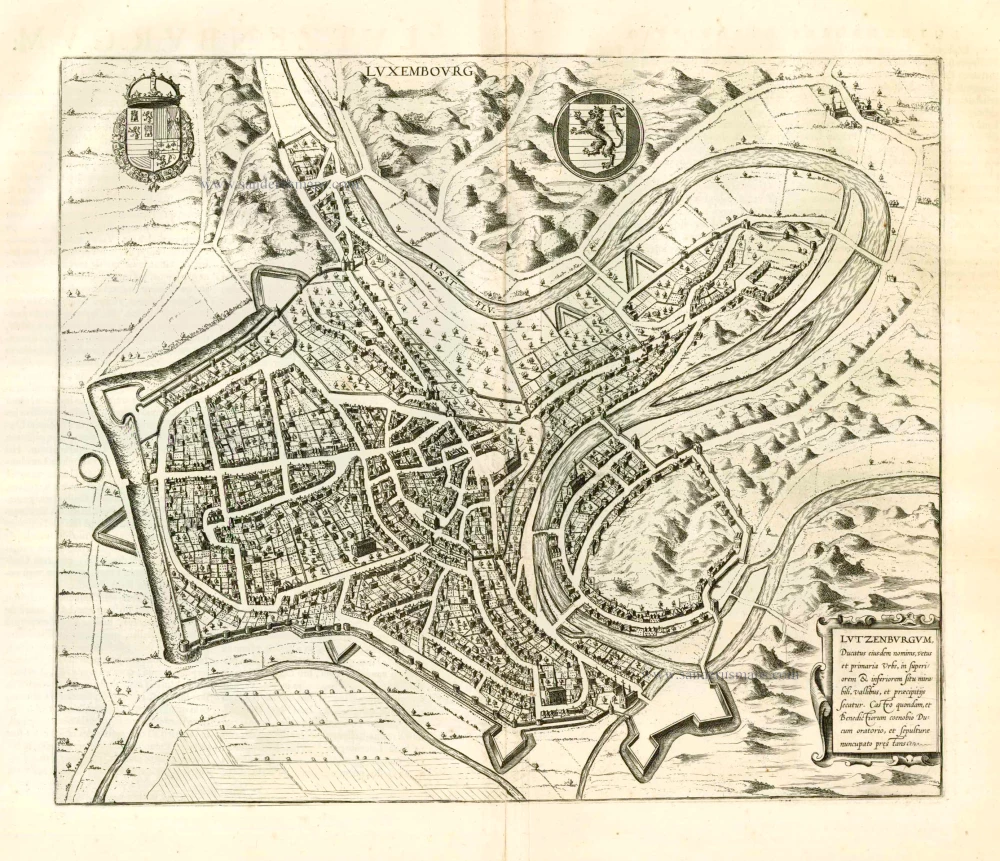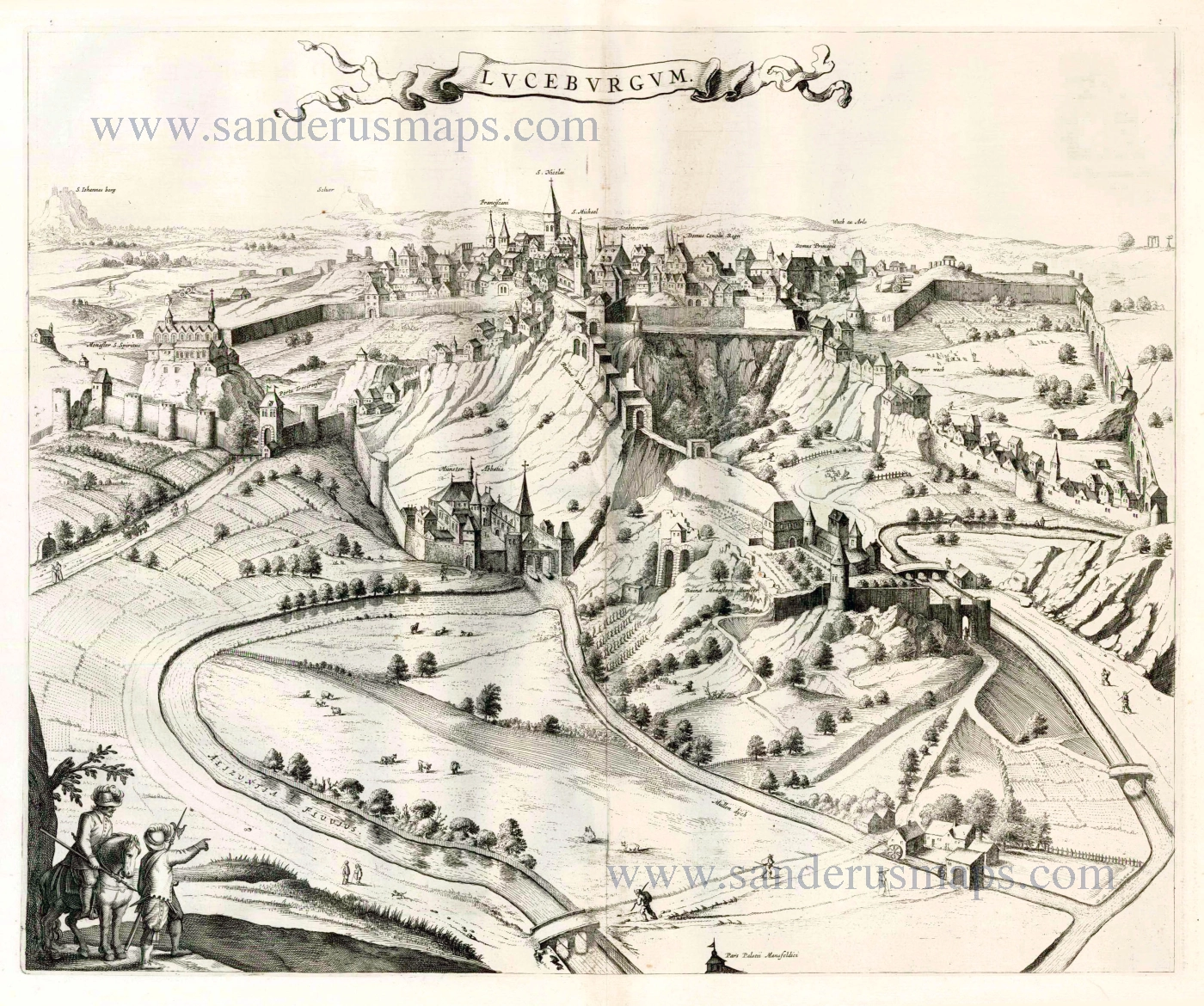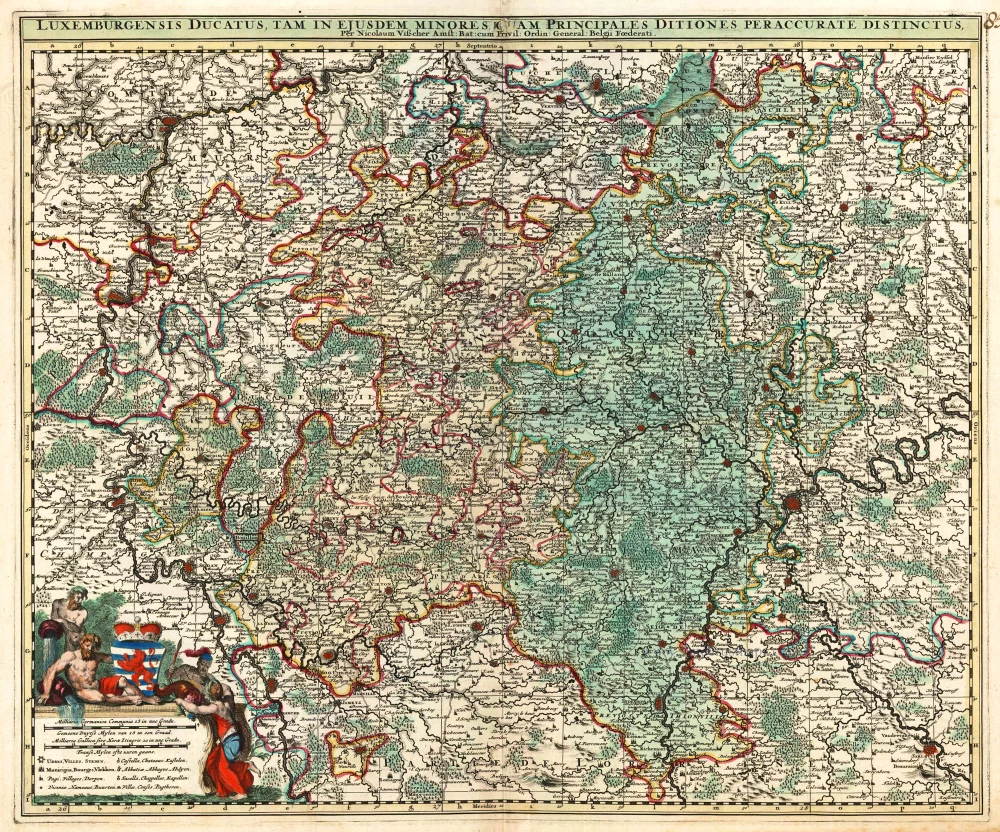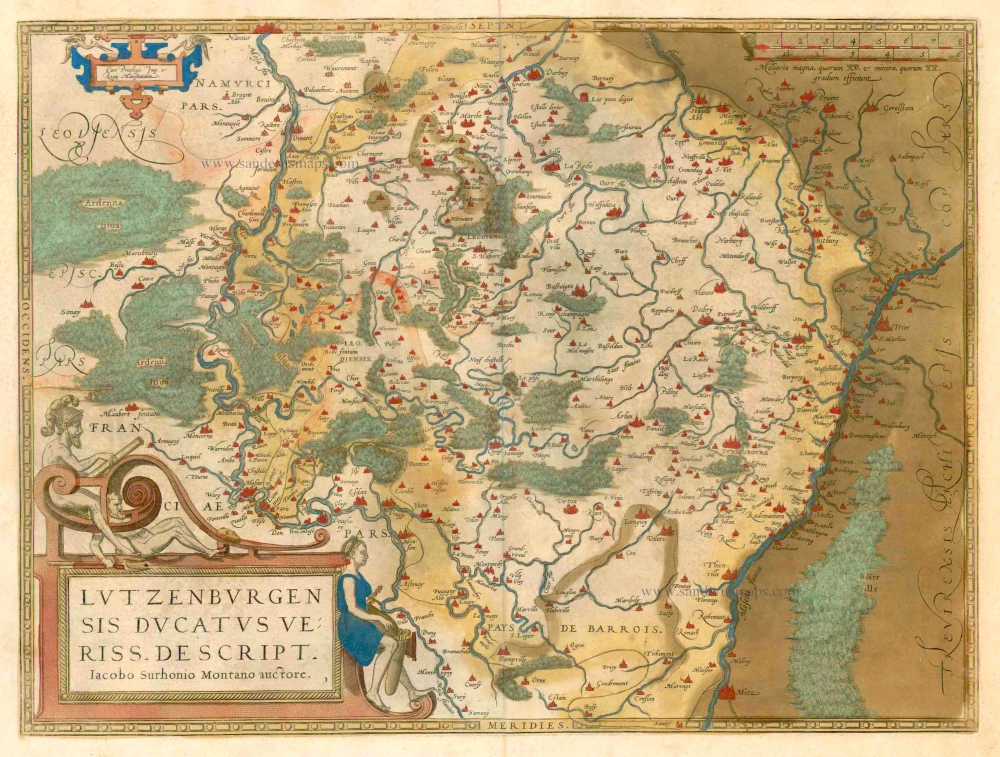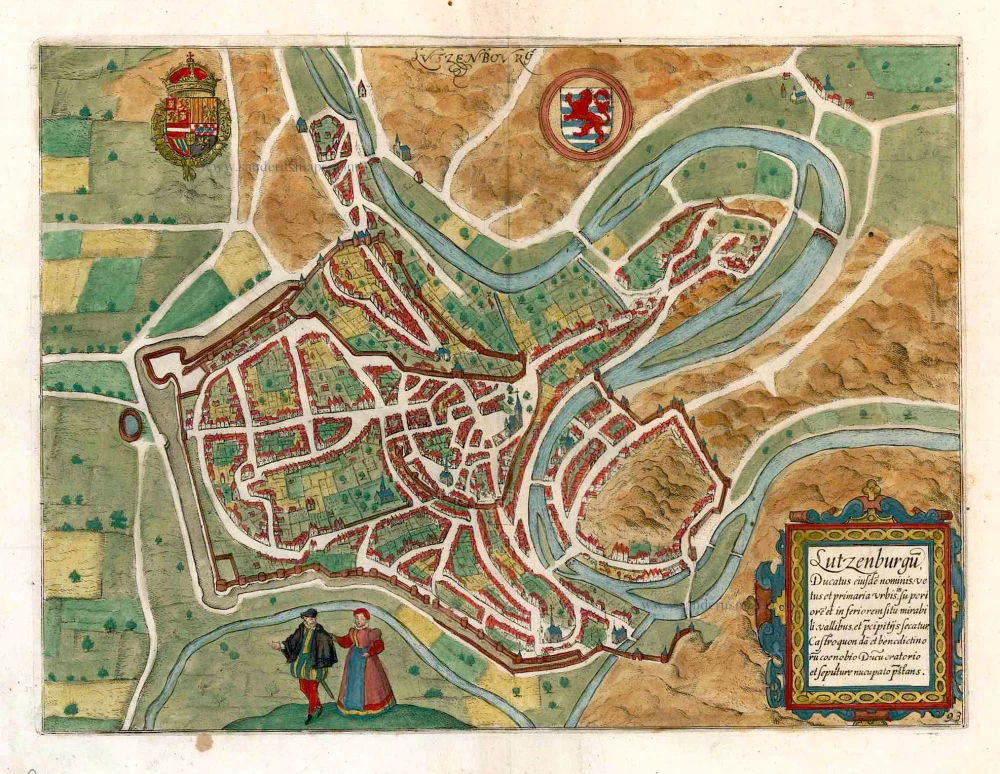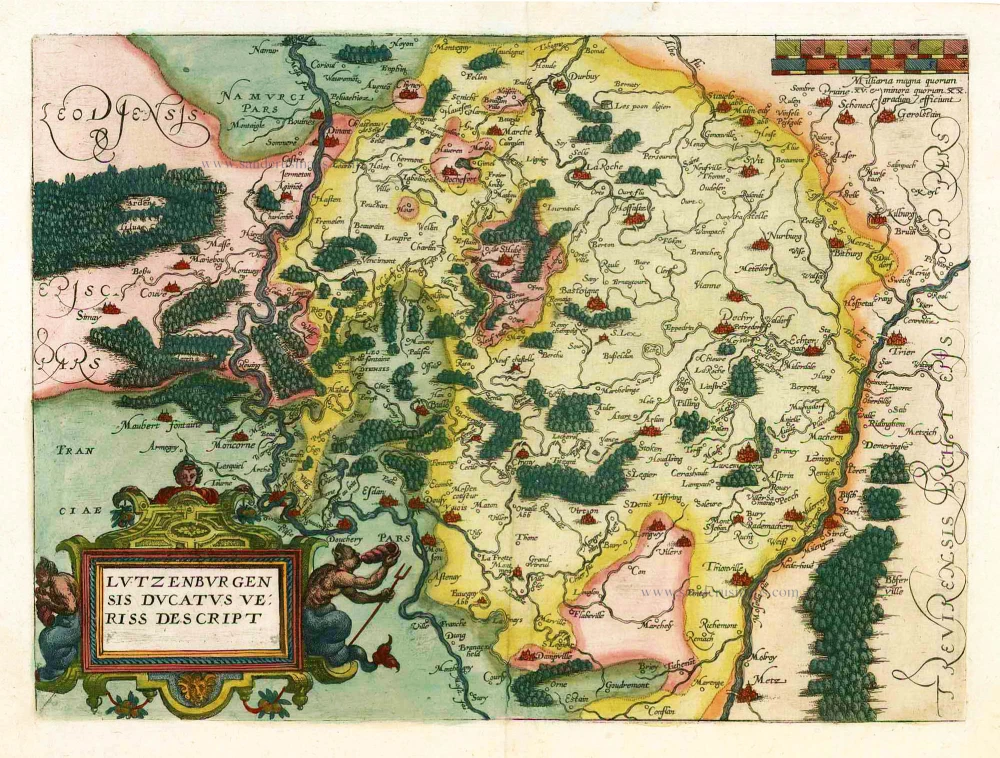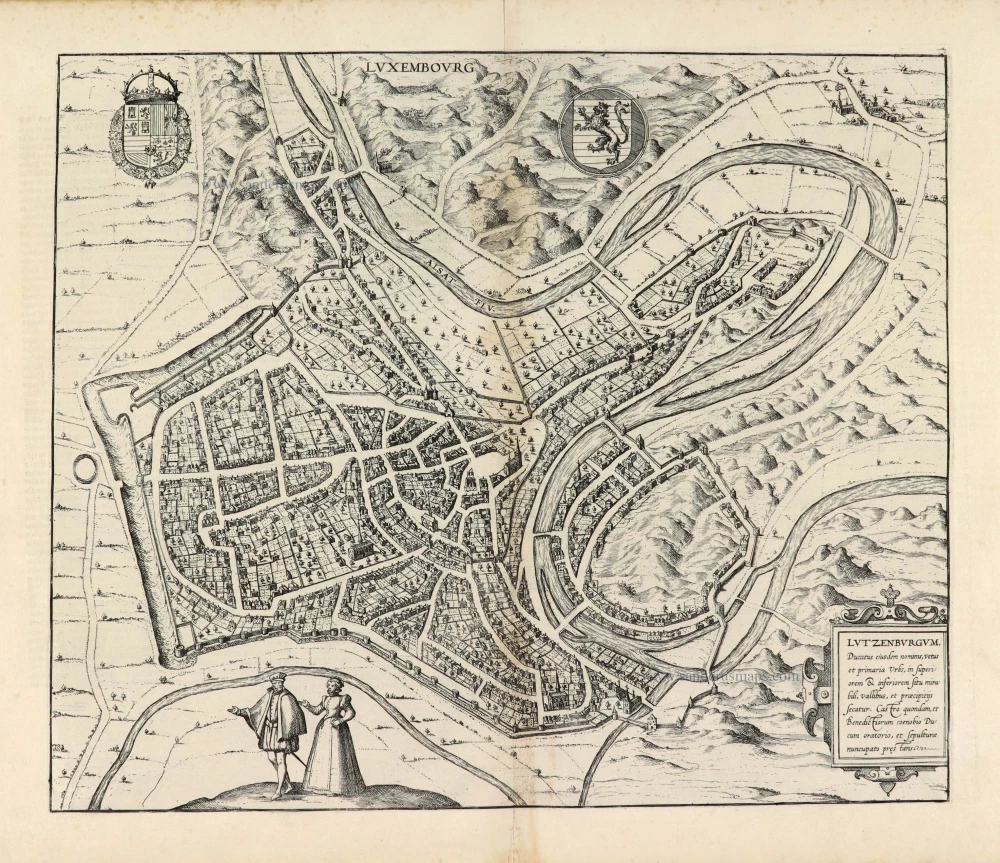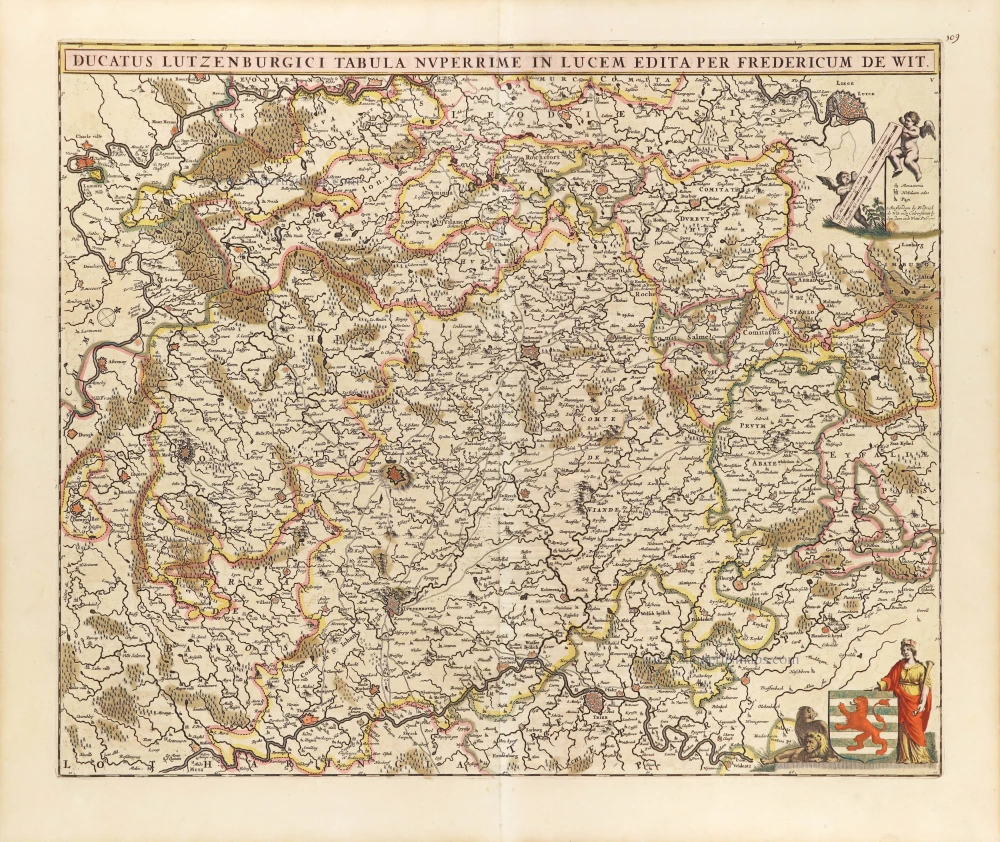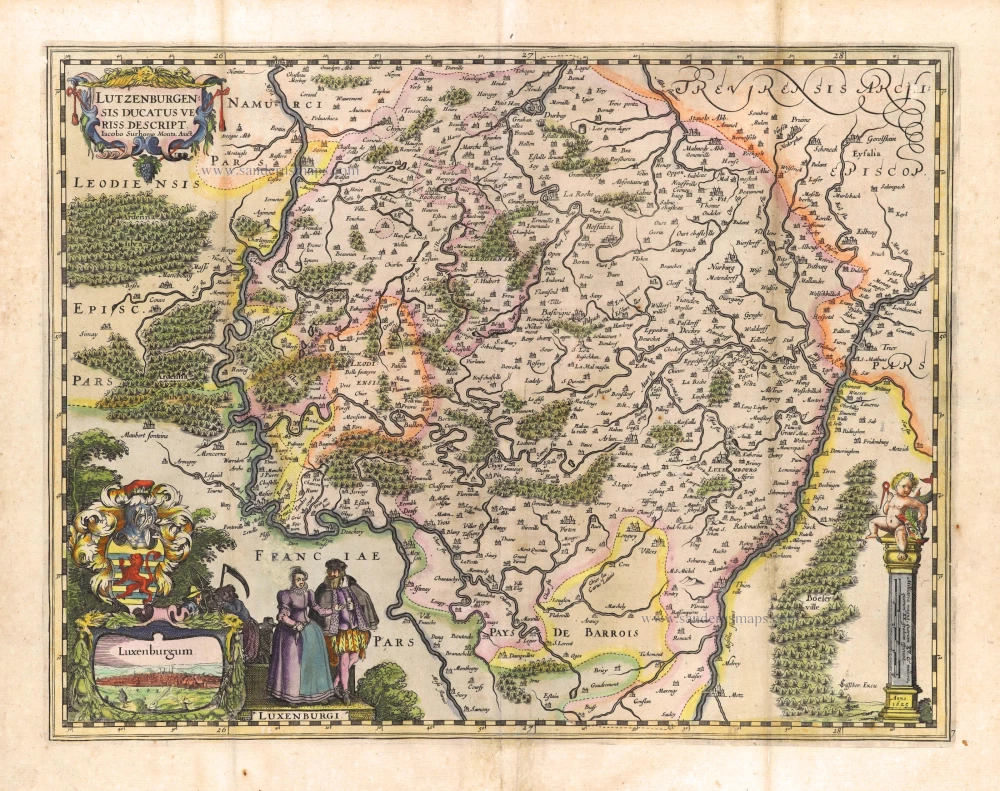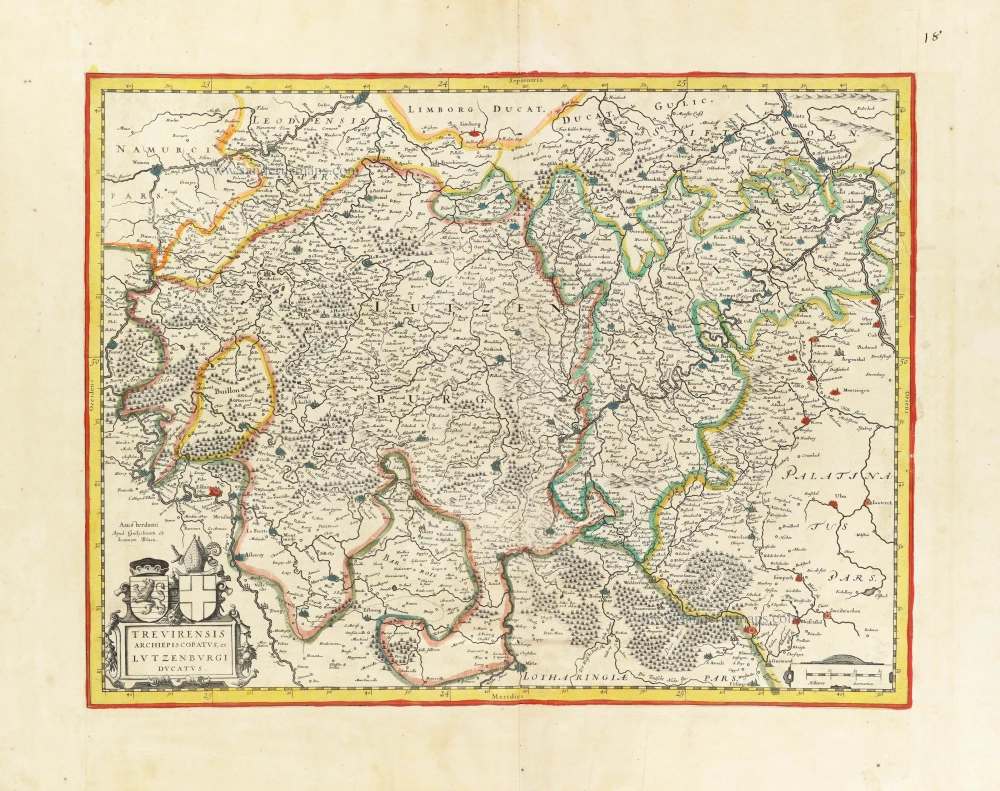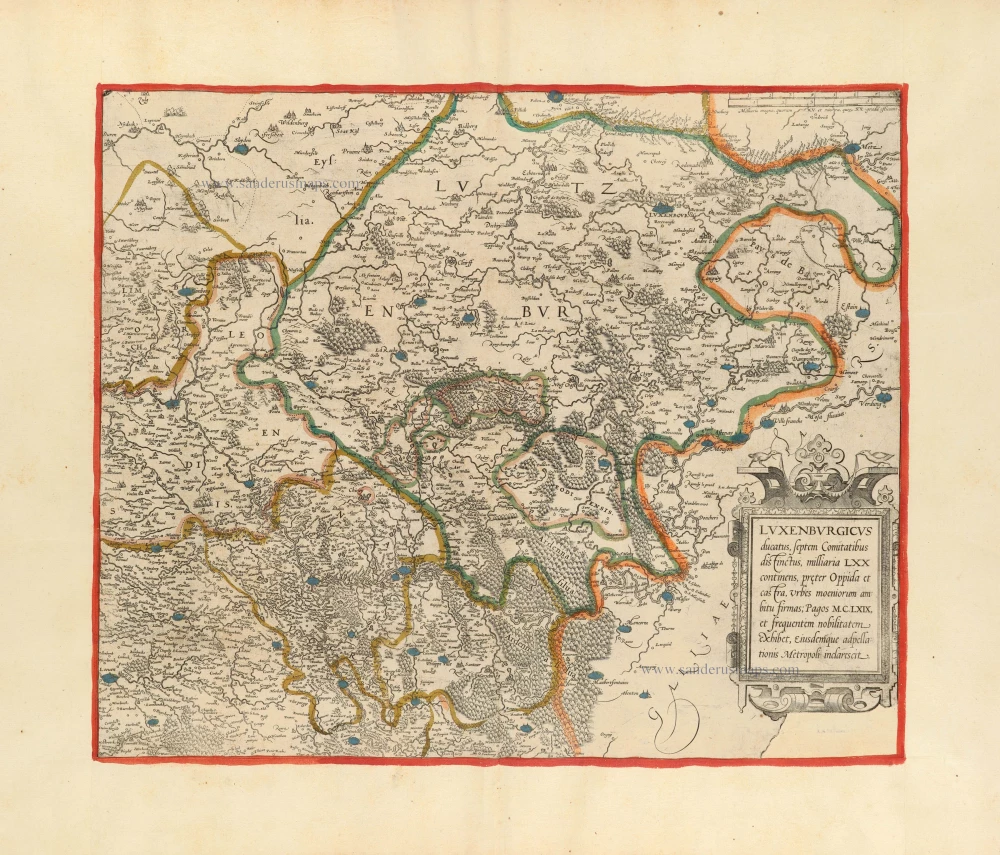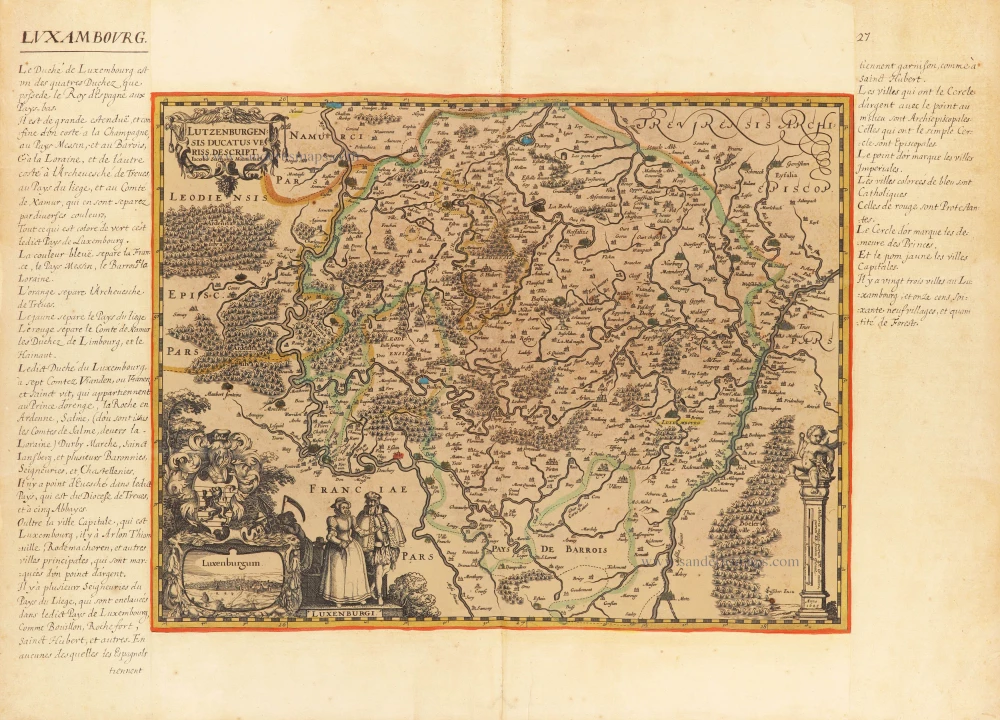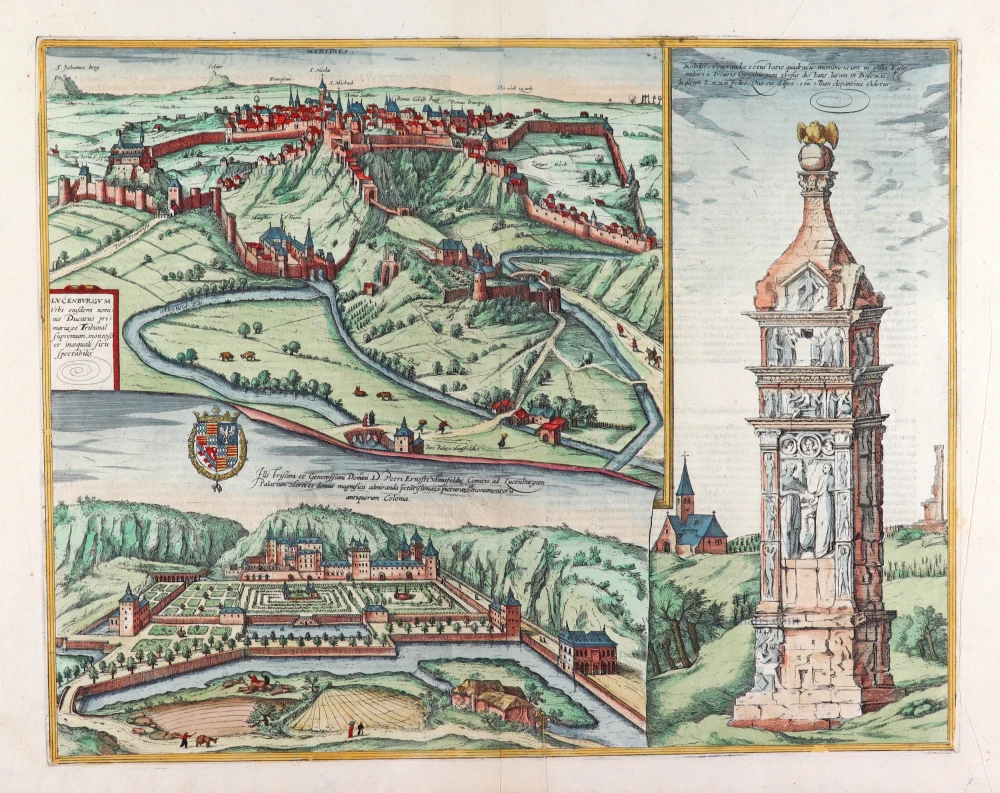Luxembourg, by J. Janssonius. 1657
TRANSLATION OF CARTOUCHE TEXT: Luxembourg, old capital of the duchy of the same name, \[...\] it was once noteworthy on account of a fortress, a Benedictine monastery and a funerary chapel of the dukes.
The bird's-eye view from the south illustrates the city's solid ramparts and its location on the River Alzette with its loop around the Bock rock. Lucilinburhuc castle was acquired in AD 963 by Count Sigefroi. In 987 the archbishop of Trier consecrated the castle chapel, which stood on the site today occupied by the church of Saint-Michel. In 1354 Luxembourg was elevated from a county to a duchy. It was captured by Burgundy in 1443 under Philip the Good. Under Louis XIV the city was annexed to France (1684-1697) and transformed into one of the most formidable fortresses in Europe by the architect Sébastien Le Prestre Marquis de Vauban. (Taschen)
The Janssonius Family
Joannes Janssonius (Arnhem, 1588-1664), son of the Arnhem publisher Jan Janssen, married Elisabeth Hondius, daughter of Jodocus Hondius, in Amsterdam in 1612. After his marriage, he settled down in this town as a bookseller and publisher of cartographic material. In 1618, he established himself in Amsterdam next door to Blaeu’s bookshop. He entered into serious competition with Willem Jansz. Blaeu when copying Blaeu’s Licht der Zeevaert after the expiration of the privilege in 1620. His activities concerned the publication of atlases, books, single maps, and an extensive book trade with branches in Frankfurt, Danzig, Stockholm, Copenhagen, Berlin, Koningsbergen, Geneva, and Lyon. In 1631, he began publishing atlases together with Henricus Hondius.
In the early 1640s, Henricus Hondius left the atlas publishing business to Janssonius. Competition with Joan Blaeu, Willem’s son and successor, in atlas production, prompted Janssonius to enlarge his Atlas Novus finally into a work of six volumes, into which a sea atlas and an atlas of the Old World were inserted. Other atlases published by Janssonius are Mercator’s Atlas Minor, Hornius’s historical atlas (1652), the townbooks in eight volumes (1657), Cellarius’s Atlas Coelestis and several sea atlases and pilot guides.
After the death of Joannes Janssonius, the shop and publishing firm were continued by the heirs under the direction of Johannes van Waesbergen (c. 1616-1681), son-in-law of Joannes Janssonius. Van Waesbergen added Janssonius's name to his own.
In 1676, Joannes Janssonius’s heirs sold by auction “all the remaining Atlases in Latin, French, High and Low German, as well as the Stedeboecken in Latin, in 8 volumes, bound and unbound, maps, plates belonging to the Atlas and Stedeboecken.” The copperplates from Janssonius’s atlases were afterwards sold to Schenk and Valck.
Luxembourg - Lutzenburgum, Ducatus eiusdem Nominis, Vetus et Primaria Urbs ...
Item Number: 9528 Authenticity Guarantee
Category: Antique maps > Europe > Luxembourg
Old antique plan of Luxembourg by J. Janssonius.
Title: Luxembourg - Lutzenburgum, Ducatus eiusdem Nominis, Vetus et Primaria Urbs ...
Cartographer: Jacob van Deventer.
Date: 1657.
Copper engraving, printed on paper.
Size (not including margins): 355 x 420mm (13.98 x 16.54 inches).
Verso: Latin text.
Condition: Lower centrefold split reinforced.
Condition Rating: A+.
From: Theatrum Urbium Celebriorum totius Belgii sive Germaniae Inferioris.Amsterdam, 1657. (Koeman, Ja 12)
TRANSLATION OF CARTOUCHE TEXT: Luxembourg, old capital of the duchy of the same name, \[...\] it was once noteworthy on account of a fortress, a Benedictine monastery and a funerary chapel of the dukes.
The bird's-eye view from the south illustrates the city's solid ramparts and its location on the River Alzette with its loop around the Bock rock. Lucilinburhuc castle was acquired in AD 963 by Count Sigefroi. In 987 the archbishop of Trier consecrated the castle chapel, which stood on the site today occupied by the church of Saint-Michel. In 1354 Luxembourg was elevated from a county to a duchy. It was captured by Burgundy in 1443 under Philip the Good. Under Louis XIV the city was annexed to France (1684-1697) and transformed into one of the most formidable fortresses in Europe by the architect Sébastien Le Prestre Marquis de Vauban. (Taschen)
The Janssonius Family
Joannes Janssonius (Arnhem, 1588-1664), son of the Arnhem publisher Jan Janssen, married Elisabeth Hondius, daughter of Jodocus Hondius, in Amsterdam in 1612. After his marriage, he settled down in this town as a bookseller and publisher of cartographic material. In 1618, he established himself in Amsterdam next door to Blaeu’s bookshop. He entered into serious competition with Willem Jansz. Blaeu when copying Blaeu’s Licht der Zeevaert after the expiration of the privilege in 1620. His activities concerned the publication of atlases, books, single maps, and an extensive book trade with branches in Frankfurt, Danzig, Stockholm, Copenhagen, Berlin, Koningsbergen, Geneva, and Lyon. In 1631, he began publishing atlases together with Henricus Hondius.
In the early 1640s, Henricus Hondius left the atlas publishing business to Janssonius. Competition with Joan Blaeu, Willem’s son and successor, in atlas production, prompted Janssonius to enlarge his Atlas Novus finally into a work of six volumes, into which a sea atlas and an atlas of the Old World were inserted. Other atlases published by Janssonius are Mercator’s Atlas Minor, Hornius’s historical atlas (1652), the townbooks in eight volumes (1657), Cellarius’s Atlas Coelestis and several sea atlases and pilot guides.
After the death of Joannes Janssonius, the shop and publishing firm were continued by the heirs under the direction of Johannes van Waesbergen (c. 1616-1681), son-in-law of Joannes Janssonius. Van Waesbergen added Janssonius's name to his own.
In 1676, Joannes Janssonius’s heirs sold by auction “all the remaining Atlases in Latin, French, High and Low German, as well as the Stedeboecken in Latin, in 8 volumes, bound and unbound, maps, plates belonging to the Atlas and Stedeboecken.” The copperplates from Janssonius’s atlases were afterwards sold to Schenk and Valck.

